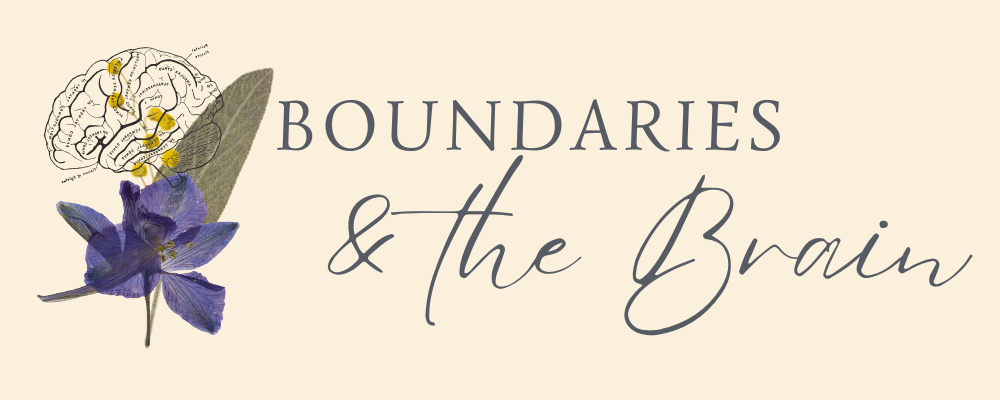Your cart is currently empty!
Boundaries and the Brain
How Your Brain Learns What’s “Too Much”
Why Boundaries Aren’t Walls — They’re Wiring
People often think of boundaries as emotional walls — rigid, cold, or unkind.
But neuroscience paints a far more elegant picture: boundaries are how your brain defines safety.
They’re not about pushing others away; they’re about teaching your nervous system what’s safe to let in and what’s not.
Every “no,” every pause, and every moment of self-respect isn’t just psychological — it’s neural architecture.
Your boundaries literally live in your brain.
How the Brain Builds Boundaries
Your brain creates emotional boundaries the same way it learns anything else — through experience, repetition, and feedback.
1. The Amygdala — The Alarm System
The amygdala detects threat. When you sense danger — whether physical or emotional — it sends signals that trigger fear, tension, or anxiety.
If your boundaries were ignored or punished in the past, your amygdala becomes hypervigilant or confused:
- You might overreact to small slights (false alarms), or
- You might freeze and suppress your needs (alarm fatigue).
This confusion forms the root of boundary struggles. Your brain isn’t sure when it’s safe to protect you.
2. The Prefrontal Cortex — The Wise Regulator
The prefrontal cortex (PFC) helps you make balanced decisions. It’s the rational voice that says,
“You’re not in danger — you’re just saying no.”
When the amygdala overfires, the PFC can get overridden. That’s why setting a boundary sometimes feels impossible in the moment — your emotional brain is louder than your logical one.
Practices like deep breathing, mindfulness, or even delaying your response by 10 seconds give the PFC time to regain control over the emotional surge.
3. The Insula — The Inner Compass
The insula monitors your internal state — it senses when something “feels off.”
When you agree to something that violates your limits, the insula often gives subtle signals: tightness in your chest, unease in your gut, fatigue after the interaction.
Learning to listen to these signals — and act on them — is one of the most powerful ways to strengthen your neural boundaries.
4. The Mirror Neuron System — The Empathy Bridge
Boundaries don’t just protect you — they preserve empathy.
Your mirror neurons allow you to feel what others feel, but without boundaries, that empathy becomes emotional absorption.
Healthy boundaries let you stay compassionate without merging — to feel for others without losing yourself.
Why Some Brains Struggle With Boundaries
Neuroscience shows that boundary patterns form early — long before you could consciously set them.
If you grew up in environments where:
- Saying no was unsafe,
- Your emotions were dismissed, or
- Peace depended on pleasing others,
your brain learned that self-protection equals danger.
The neural pathways for “connection at all costs” became stronger than the ones for “self-respect.”
That’s not weakness — it’s adaptive wiring. Your brain was simply choosing survival over self-expression.
How to Rewire Your Brain for Healthier Boundaries
Neuroplasticity — your brain’s ability to change — means boundaries can always be relearned.
It’s never too late to teach your nervous system that safety and self-worth can coexist.
1. Start with Sensation
When you feel discomfort in a situation, pause and name it:
“Something in me feels tense.”
That moment of awareness activates the prefrontal cortex and starts reshaping your response.
2. Pair Safety with Self-Assertion
Each time you assert a small boundary and nothing terrible happens, your amygdala updates its “threat file.”
Your brain literally learns that saying no is safe.
Repeat that often enough, and your guilt transforms into calm confidence.
3. Use the “Prefrontal Pause”
Before you respond to a request or comment, take a slow breath and let the rational brain come online.
This microsecond of awareness creates neural space — it separates emotion from decision.
Over time, this pause rewires impulsive compliance into mindful choice.
4. Visualize Your Boundary System
The brain loves imagery.
Imagine your mind as a home: boundaries are not locked doors — they’re gates with conscious control.
You decide who enters, how long they stay, and when it’s time to close the gate.
That visualization activates both emotional and logical circuits, reinforcing your sense of agency.
5. Reframe Guilt as Growth
When you first start setting boundaries, guilt is inevitable — but it’s also a sign of neural change.
Your brain is adjusting to a new pattern, one where your peace matters.
Each wave of discomfort is your nervous system learning balance, not rebellion.
Boundaries as Emotional Homeostasis
Think of boundaries as the brain’s version of homeostasis — keeping internal balance despite external pressure.
Just as your body regulates temperature, your emotional brain regulates closeness and distance.
Without boundaries, you overheat.
With too many walls, you freeze.
Healthy boundaries are your mind’s optimal temperature for safety and connection.
The Spiritual and Neural Intersection
Even spiritual traditions echo what neuroscience confirms: that compassion without self-awareness leads to depletion, not virtue.
When you protect your peace, your brain stays regulated, allowing you to love more authentically and respond more wisely.
In essence — boundaries are the meeting point of neurobiology and self-respect.
Final Thought
Boundaries aren’t selfish. They’re synaptic self-care — living proof that your brain is learning it deserves safety and peace.
Every “no,” every pause, every breath before reacting — it’s not weakness.
It’s your brain remembering:
“I’m safe enough to protect my energy.”
This article is part of our Boundaries and the Brain series. Explore related reads below to understand how your brain handles guilt, empathy, and emotional balance.”
by
Tags:

